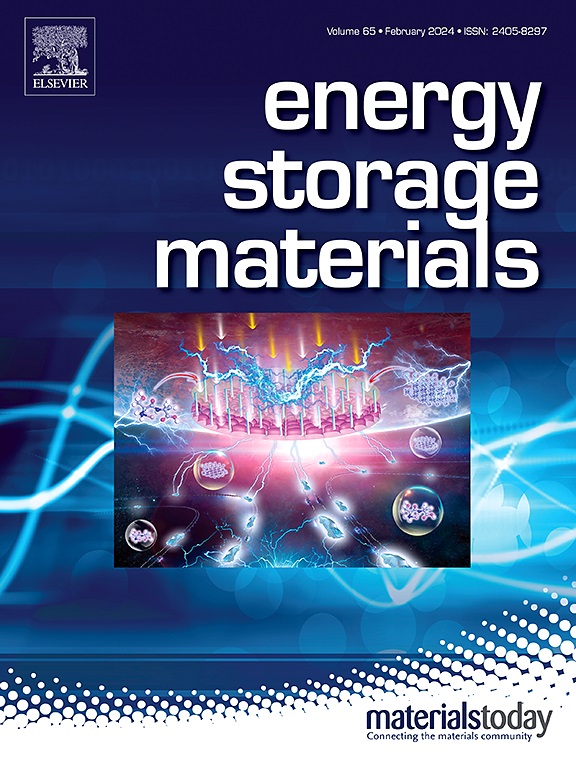通过对称极化效应抑制醌溶解以实现超稳定质子电池
IF 20.2
1区 材料科学
Q1 CHEMISTRY, PHYSICAL
引用次数: 0
摘要
水电池具有安全性高、成本低、环境友好等优点,有望成为下一代电池。然而,几十年来,水电池一直受到电极溶解问题的困扰,这是由于氢键的形成,特别是在酸性型水质子电池中。本研究表明,对称极化结构材料有效地解决了电极的溶解问题,因为其反氢键框架阻碍了羰基(C=O)与水分子之间氢键的形成。结果表明,这些对称极化效应诱导电极在1M H2SO4溶液中浸泡500天后没有出现电极溶解现象,并在10 a g−1下稳定循环40000次超长循环。因此,本研究对质子电池的超稳定电极设计进行了令人信服的分析,从而展示了在高腐蚀性环境中电极结构的新机会。本文章由计算机程序翻译,如有差异,请以英文原文为准。
Inhibition of quinone dissolution via symmetrically polarized effect for ultra-stable proton batteries
Aqueous batteries hold promising prospects as the next generation of batteries due to their high safety level, low cost, and environmental friendliness. However, for decades, aqueous batteries have been plagued by electrode dissolution issues, which are attributed to the formation of hydrogen bonds, particularly in acidic-type aqueous proton batteries. Herein, this work reveals that symmetrically polarized structural materials effectively solve the dissolution issue of electrodes, owing to an anti-hydrogen bond framework that hinders the formation of hydrogen bonds between the carbonyl (C=O) group and water molecules. As a result, these symmetrically polarized effect-induced electrodes exhibit no electrode-dissolution phenomenon after being immersed in 1 M H2SO4 solution for 500 days and achieve stable cycling for 40,000 ultra-long cycles at 10 A g−1. Therefore, this study presents a compelling analysis of the ultra-stable electrode design in proton batteries, thereby demonstrating new opportunities for electrode construction in highly corrosive environments.
求助全文
通过发布文献求助,成功后即可免费获取论文全文。
去求助
来源期刊

Energy Storage Materials
Materials Science-General Materials Science
CiteScore
33.00
自引率
5.90%
发文量
652
审稿时长
27 days
期刊介绍:
Energy Storage Materials is a global interdisciplinary journal dedicated to sharing scientific and technological advancements in materials and devices for advanced energy storage and related energy conversion, such as in metal-O2 batteries. The journal features comprehensive research articles, including full papers and short communications, as well as authoritative feature articles and reviews by leading experts in the field.
Energy Storage Materials covers a wide range of topics, including the synthesis, fabrication, structure, properties, performance, and technological applications of energy storage materials. Additionally, the journal explores strategies, policies, and developments in the field of energy storage materials and devices for sustainable energy.
Published papers are selected based on their scientific and technological significance, their ability to provide valuable new knowledge, and their relevance to the international research community.
 求助内容:
求助内容: 应助结果提醒方式:
应助结果提醒方式:


